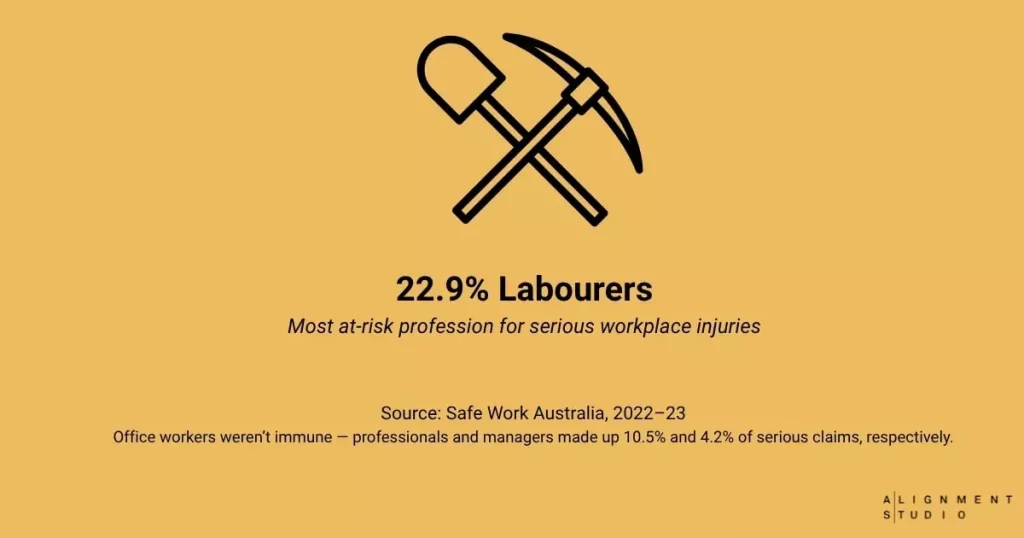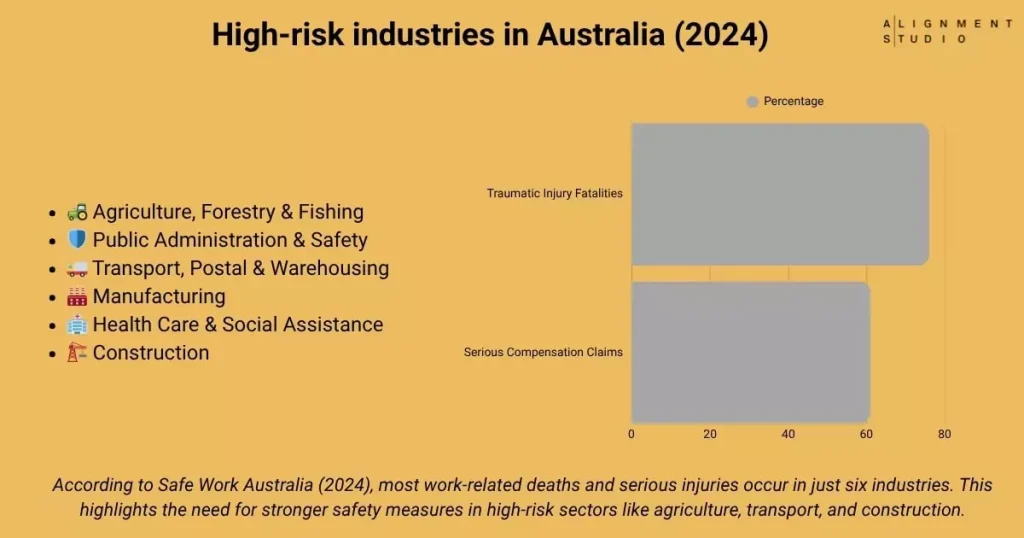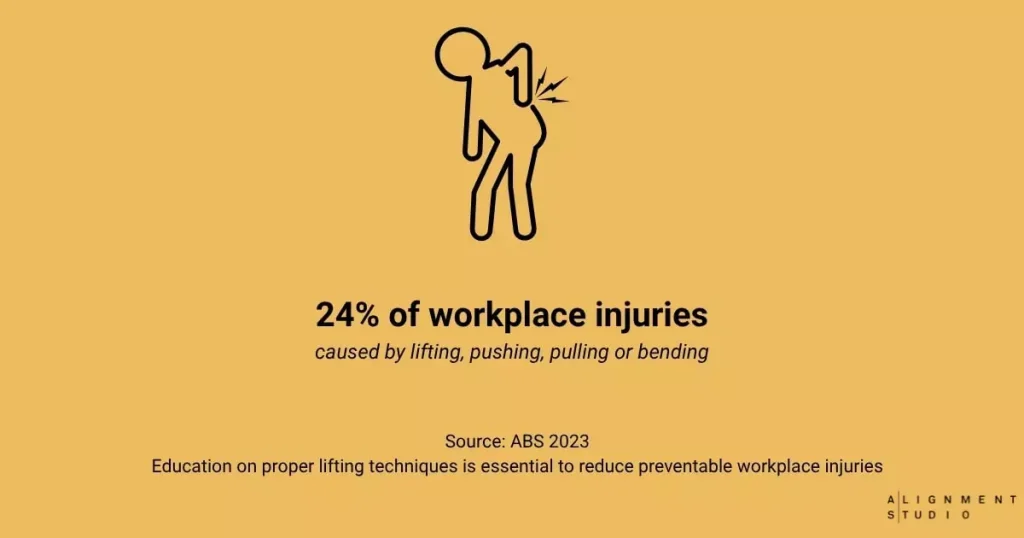From burns to back pain, minor falls to fatalities, workplace injuries in Melbourne come with a significant cost to employers and the economy. Not to mention the individuals and families involved.
According to WorkSafe Victoria statistics, over 25,500 injured Victorian workers had compensation claims accepted in 2024. And a 2024 Safe Work Australia report reveals we’d be $26.8 billion better off as a nation if work-related injuries and illnesses were averted each year.
While Victoria’s annual figure is not reported, the state’s compulsory WorkCover insurance premium for 2024–25 indicates a significant cost. Set at an average rate of 1.8% of total remuneration, this would equate to a direct cost of $3.6 billion for a $200 billion payroll (combined amount paid by all Victorian employers).
So, what workplace injuries are most prevalent, and what role does physiotherapy play in their prevention and rehabilitation? Read on for 37 fascinating insights into work-related injuries in Melbourne – and learn how our skilled and experienced team can help.
Melbourne Workplace Injuries: Stats and Facts
#1 Musculoskeletal injuries are the most common workplace injuries
Encompassing sprains, strains and pains from heavy lifting, repetitive actions or long hours spent sitting, musculoskeletal injuries (MSIs) account for the highest number of workplace injuries in Australia.
#2 Over 25,500 Victorian compensation claims were approved in 2024

This number, reported by WorkSafe Victoria, constitutes claims for serious injury. However, the incidence of unreported work-related injury or illness is likely much higher.
Safe Work Australia puts the rate at 3.5% of the national workforce, which suggests many Victorians may suffer from more minor, unreported concerns.
#3 Melbourne recorded 33 workplace fatalities last year
According to WorkSafe Victoria data, there were 50 Victorian workplace fatalities in 2024, the majority of which were in metropolitan Melbourne. The transport, warehousing and postal industry accounted for the most fatalities, followed by construction.
#4 Victorian fatalities have been decreasing since 2021
Statewide, the number of workplace tragedies has been declining each year. From a confirmed total of 91 individuals in 2021, it dropped to 73 in 2023 and 50 in 2024. A trajectory we hope continues.
#5 Labourer is the most at-risk profession – nationwide

Of the serious claims made in 2022–23, the majority (22.9%) were made by labourers, according to Safe Work Australia’s Key Work Health and Safety Statistics 2024 report. Office workers weren’t exempt, however, with professionals and managers submitting 10.5% and 4.2% of claims, respectively.
#6 Driving can be deadly
In the same period, 42% of the fatalities were vehicle-related. On and off-road accidents involving vehicles were also the major cause of Victorian worker fatalities, accounting for 16 of 50 deaths in 2024.
#7 Most injuries occur in 6 industries

Concerningly, most incidents are concentrated in just six industries. According to the 2024 Safe Work report, 76% of work-related traumatic injury fatalities and 61% of serious workers’ compensation claims occurred in:
- Agriculture, forestry and fishing
- Public administration and safety
- Transport, postal and warehousing
- Manufacturing
- Health care and social assistance
- Construction
#8 Small businesses may be less safe
According to the WorkSafe Victoria website, of the workplace fatalities in 2024, over half occurred in small businesses.
#9 Victorians aged 45+ account for most claims
Most Victorian workers’ compensation claims are made by older workers, 45 and over. Australia-wide, the 45 to 54-year-old bracket accounts for around 24% of all serious claims.
#10 Most workplace injuries occur in men
Statewide and national statistics show men make more workers’ compensation claims than women. This is highlighted in a 2018 Monash research report analysing 71,607 Victorian claims, with 65.8% made by men.
#11 Monash metric finds we lose the equivalent of 41,000 jobs a year
According to Monash University’s “Working Years Lost” metric, Australia loses 41,194 work years annually through work-related injury and illness.
Published in the Medical Journal of Australia, the research found that “Occupational injury and disease covered by workers’ compensation result in lost working time in Australia equivalent to more than 41,000 full-time jobs.”
#12 Fatigue causes nearly 10,000 serious work accidents a year
Asleep on the job? It’s risky business. A major cause of work and road accidents, fatigue costs the Australian economy over $5 billion a year in lost productivity and healthcare.
Source: Monash University
#13 Shiftworkers are particularly vulnerable
2013–14 survey findings outlined in a 2016 Safe Work Australia report highlighted the increased risk faced by shiftworkers. With fatigue the key risk factor, shiftworkers had more than double the rate of injury.
Not All Injuries Are Physical
#14 Mental health claims are increasing
In Australia, individuals can file claims for psychological injuries, as well as physical injuries, arising from their job. Psychological injury can include post-traumatic stress disorder (PTSD), depression and anxiety disorders. They accounted for 10.5% of serious claims in 2022–23 – a figure that’s increased by 97.3% compared with 10 years ago.
#15 Women make the majority of mental health claims
While physical injury claims by men far outweigh those by women, women are more likely to make mental health claims.
#16 Time lost to psychological injury is 5 times greater
Interestingly, both time lost and compensation paid for mental health claims are much higher. At 37 weeks, the median time lost due to psychological injury in 2022-23 was more than 5 times that recorded across all physical injuries/diseases.
Recovery Timelines and Early Intervention
The road back to work is different for everyone. Physiotherapy plays a vital role in the rehabilitation of workplace injuries, significantly reducing recovery time.
#17 Early physio intervention expedites return to work
Since 2014, WorkSafe Victoria’s Early Intervention Physiotherapist Framework (EIPF) has helped injured workers recover faster, with an earlier return to work. A three-year evaluation of the program found workers treated by EIPF-trained physiotherapists returned to work an average of 21 days sooner than those under standard physio care.
The EIPF plays a vital role in the early intervention of workplace injuries, significantly reducing recovery time.
#18 Younger workers are back on the job sooner
When it comes to the fastest return to work, the youth have it. The same analysis revealed that workers with fractures aged 15 to 24 returned to work sooner than older workers. The slowest to return? Workers with musculoskeletal injuries aged 45–54.
#19 Stress and fractures lead to longer absences
Outlining 2021–22 statistics on work-related injuries in Australia, an Australian Bureau of Statistics report released in 2023 found that, among the 66% of injured workers who took time off, leave was longest for mental health conditions.
Average absence by injury:
- Stress or other mental health conditions – 44 days
- Fractures or broken bones – 29 days
- Chronic joint or muscle conditions – 22 days
#20 Women are less likely to return to work
Data suggests women are less likely than men to return to work after a workplace injury. Additionally, Victorian research found women with dependent children and a long-term (6-month-plus) injury took longer to return to work than other groups.
#21 The longer RTW is delayed, the less likely it is
For employers, time is of the essence, with extended time off due to injury or illness reducing the likelihood of a return to work.
#22 Early intervention helps prevent secondary conditions
According to global health, employment, disability, and workplace services provider APM, “Faster access to support and treatment can also prevent complications, make the recovery and rehabilitation smoother and shorter, and help prevent the development of mental health issues.”
#23 Employers who act early reduce their costs
APM also advise that providing support from the get-go can shorten the duration of injury claims and minimise productivity losses and recruitment fees.
#24 Supportive employers improve return-to-work outcomes
Unsurprisingly, a positive and supportive workplace culture makes a big difference. WorkSafe Victoria says workplaces that prioritise staff wellbeing enjoy improved RTW rates and fewer long-term absences.
How Physiotherapy Helps
Whether you’re a worker seeking relief from pain or an employee wanting to reduce productivity losses due to injury, physiotherapy can help.
#25 Physio assists in pain reduction
Using techniques such as manual therapy, stretching, mobilisation, shockwave therapy and dry needling, physiotherapy helps to reduce acute and chronic pain.
#26 Recovery time and return-to-work rates improve with physio care
Prompt access to physiotherapy accelerates healing, helps restore function and reduces the likelihood of developing chronic conditions. As physios, we create tailored treatment plans that consider the individual and the requirements of their job, structuring a program that will get them workplace-ready sooner.
#27 Physios are experts in musculoskeletal injuries
Most workplace injuries are musculoskeletal, with traumatic joint/ligament and muscle/tendon injuries constituting 35.5% of serious claims in 2022–23, and musculoskeletal and connective tissue diseases, 14.5%.
Whether sport or work-related, physiotherapists treat MSIs day in and day out.
#28 Physio reduces costs for employers
Early physio intervention can help prevent the need for expensive surgery and accelerate an employee’s return to work, reducing direct and indirect costs
#29 On-site physiotherapy prevents injuries
According to the Australian Physiotherapy Association, “Occupational physiotherapists proactively roam onsite and provide on-the-job education and training to employees, such as correct manual handling techniques, safe work area set up, or ergonomic analysis. This helps to prevent injuries from occurring and promotes a culture of safety in the workplace.”
#30 Onsite and early physio programs make economic sense
The APA also states that immediate treatment can significantly reduce lost productivity and the cost of compensation claims and insurance premiums.
#31 Education and improved body mechanics reduce future injury risk
As physios, we don’t just treat injuries. We provide valuable education on ergonomics and correct posture, assess body mechanics, and prescribe exercises to reduce injury recurrence.
#32 Rehabilitation improves mental health outcomes
Injury Prevention Insights
Injury prevention necessitates clear safety protocols, compliance with industry regulations, regular checks and inspections and a culture of open communication.
#33 If leaders value safety, so do employees
According to Safe Work Australia, compliance with workplace health and safety protocols trickles down from the top.
If workers know their leaders place high importance on WHS, it becomes part of everyday work. Workers become more likely to follow safety procedures and raise safety issues, making health and safety part of culture.
#34 Ergonomic setups save money
Poor ergonomics is a major cause of work-incurred musculoskeletal injuries such as neck pain and RSI. Research shows that providing workers with ergonomic workstations and tools reduces the risk of injury and absenteeism, increases productivity and job satisfaction and reduces healthcare costs.
#35 Education on proper lifting is essential

The 2023 ABS report found the most common cause of injury or illness to be ‘lifting, pushing, pulling or bending’ (24%) – highlighting the need to provide education on safe techniques.
#36 Regular breaks help prevent breaks
Whether driving, operating machinery, or at a desk, regular breaks promote musculoskeletal health and reduce fatigue. Physios can also recommend stretches to mitigate job-related repetitive postures or movements.
#37 Workplace safety and wellbeing tips are readily available
WorkSafe Victoria publishes industry-specific guides and compliance kits online. Get yours here.
Ready to Recover or Prevent a Work Injury in Melbourne?
At The Alignment Studio, our expert team of physiotherapists in Melbourne CBD accelerates office injury recovery with a skilled team and cutting-edge equipment.
We offer workplace ergonomic assessments, injury prevention physiotherapy and EIFP rehabilitation services. Book online today or call us on 03 9650 2220 to learn how we can help.




